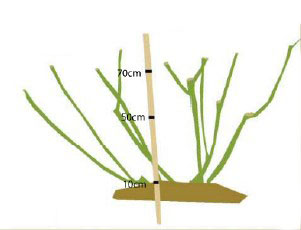 |
| The Kindest Cut Flowers - Roses |
This beautiful display of roses is one of the rewards of winter pruning, along with good soil enrichment, watering and fertilizing. This cape garden features a wonderful selection of bush and climbing roses, including the tall pink ‘Queen Elizabeth’, the lower-growing floribunda ‘Bridal Pink’ and the floribunda ‘Orange Bunny’. Other roses that would produce the same effect are ‘Adele Searll’ and ‘Clever Gretel’, instead of ‘Orange Bunny’
Wherever roses are grown, you can be sure that winter pruning is always a major topic in magazines and newsletters, with plenty of tips and advice, dos, don'ts and details.
I recently received the newsletter from The American Rose Society, probably the largest of all rose societies, and their approach to pruning is exactly the same as ours: keep it simple, don't worry about inner or outer eyes or the angle of cuts, and, most important of all. Know "that you cannot hurt a plant, much less kill it, by 'underprunlng' or 'overpruning' it".
In California, trials were conducted over a number of years where a third of roses were pruned conventionally, another third with power hedge trimmers and the final third with hand shears in a fast shaping process.
'Year after year" reports the newsletter, 'the two fastest pruning methods yielded better results in terms of growth than the classical method". And the pruning rate was five roses a minute! Watch this space next year we'll show you how to prune your roses with power hedge trimmers!
 |
| The Kindest Cut Flowers - Ready to Prune |
ROSE PRUNING BASICS
When to prune
In most areas roses can be pruned from mid July until mid August, except in very cold areas where pruning should be delayed until mid-August.
Prune for health and neatness
For roses to thrive, cut out old, diseased or twiggy growth and clean out the centre of the plant so it has room to grow. One also prunes to neaten or shape a bush, or reduce its height or spread.
Know what you want
Light pruning results in smaller blooms in a greater quantity, and a lightly pruned bush will bloom earlier than one that has been pruned hard. Hard pruning results in fewer flowers that are larger and of better quality. Pruning can't change the nature of a rose, like turning a climber into a hybrid tea. So find out how a rose wants to grow and go with the flow when pruning It.
Don't forget the aftercare
This is even more important than the pruning. Replenishing the nutrients in the soil sets up the rose for the next season. After pruning, dig over the soil to a depth of 15-30 cm and mix In the old mulch and plenty of compost.
ROSE PRUNNING STEP-BY-STEP
This illustrated step-by step guide gives three pruning options- light, medium and hard. Chose the option that's best for the rose, your garden or your taste. Getting ready to prune Rose varieties that benefit most from this method of pruning are hybrid teas, floribundas and the bush types of the English and nostalgia roses. Note the stick pushed in next to the rose, marked off at 50 cm and 70 cm. This makes it easy to cut the rose down to The correct height. All you need is a 1 m-long stick. From the bottom, mark off the first 10 cm. That is the depth that the stick is pushed into the ground. From the 10 cm mark, measure off 50 cm and 70 cm.
 |
| The Kindest Cut Flowers - Step 1 |
Push the stick into the ground and cut off all the growth level with the top of the stick (which is higher than the 70 cm mark).This makes it easier to look into the bush and identify the older wood, criss-crossing stems and the past season’s basal stems that should be retained.
Step 2 – Light pruning
 |
| The Kindest Cut Flowers -Step 2 |
 |
| The Kindest Cut Flowers - Step 3 |
For a nearer-looking, better-shaped and well-balanced bush, now reduce the length of the stems to 70 cm. Remove or shorten the remaining side stems and criss-crossing growth and reduce forks to a single tine. Moderate pruning is done if you feel that the roses need more pruning than light pruning but that hard pruning is too severe. It Is the middle ground and probably the most suitable option for most gardens. The rose will produce good quality blooms on a mixture of short and long stems.
 |
| The Kindest Cut Flowers -Step 4 |
Step 4 - Hard Pruning
This final option selects 3-4 healthy stems and cuts these down to 50 cm above the ground, removing all remaining side stems and forks.
This option is only recommended for roses that are grown dose together, and where long, pick able stems and exhibition class blooms are required. With this pruning it is essential to:
 |
| The Kindest Cut Flowers - Roses |
 |
| The Kindest Cut Flowers - Roses |
- Correctness of upper cut is not important
No comments :
Post a Comment